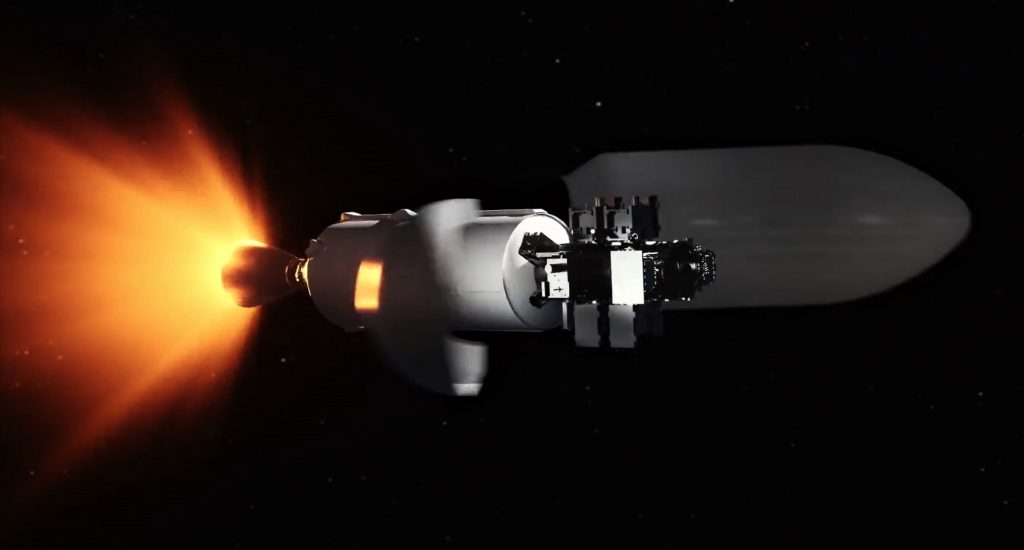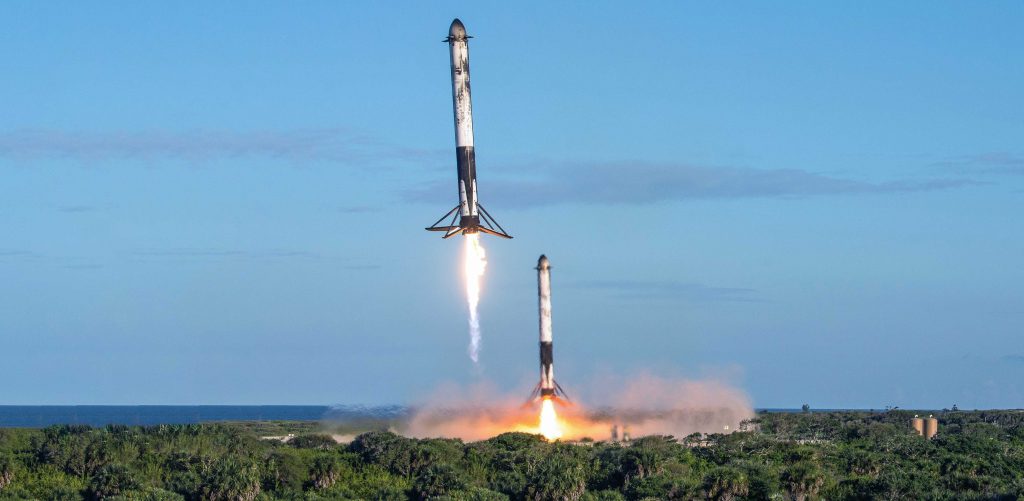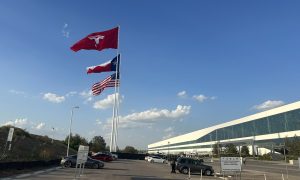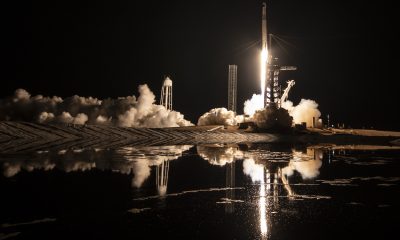

News
SpaceX’s Falcon Heavy flies a complex mission for the Air Force in launch video
SpaceX has gone to unique lengths for the third launch of its Falcon Heavy rocket and made an exhaustive webpage dedicated to the mission, reviewing its importance to SpaceX and the United States and discussing most of its 23 manifested spacecraft.
Known as the US Air Force’s Space Test Program 2 (STP-2) mission, Falcon Heavy Flight 3 will be a critical pathfinder for the US military’s systematic utilization of both Falcon Heavy and its flight-proven boosters.
The STP-2 mission will be among the most challenging launches in SpaceX history with four separate upper-stage engine burns, three separate deployment orbits, a final propulsive passivation maneuver and a total mission duration of over six hours. [It] will demonstrate the capabilities of the Falcon Heavy launch vehicle and provide critical data supporting certification for future National Security Space Launch (NSSL) missions. In addition, [the USAF] will use this mission as a pathfinder for the [military’s systematic utilization of flight-proven] launch vehicle boosters.
SpaceX, April 2019
SpaceX offers a very effective summary of the various challenges presented by Falcon Heavy’s STP-2 mission and third launch. It’s as challenging as it is for one very specific and largely artificial reason. All the way back in 2012, the USAF contracted the launch to give SpaceX a low-risk opportunity to demonstrate specific capabilities the military branch requires before they certify a given rocket to launch high-value payloads. Originally intended to fly STP-2 in mid-2015, Falcon Heavy suffered almost five years of delays during its development, caused by a combination of unexpected technical difficulties and two catastrophic Falcon 9 failures in 2015 and 2016.

After spending the whole of 2017 gradually catching up on delayed customer launches, SpaceX successfully conducted Falcon Heavy’s launch debut on February 6th, 2018. Four months later, the Air Force announced that it had completed the SpaceX rocket’s preliminary certification and awarded the company a $130M launch contract for AFSPC-52, a classified military satellite. According to documents describing the mission, the satellite weighs approximately 6350 kg (~14,000 lb) and needs to be placed into a geostationary transfer orbit (GTO) measuring 35,188km X 185km (21,850 mi X 115 mi).
Conveniently, Falcon Heavy’s commercial launch debut saw the massive rocket deliver the communications satellite Arabsat 6A – weighing ~6450 kg (~14,200 lb) – into an extremely high GTO, almost 90,000 km X 330 km (56,000 mi X 205 mi). In simpler terms, Falcon Heavy Flight 2 was an almost perfect demonstration that SpaceX is more than capable of successfully launching AFSPC-52, a milestone that could come as early as H2 2020.


The STP-2 mission should help to boost the US military’s confidence in Falcon Heavy even further. The mission is comprised of 23 separate satellites from a dozen or so different groups, ranging from a NOAA weather satellite constellation to a NASA-built atomic clock. The purpose of such a varied range of payloads is to have SpaceX’s Falcon upper stage (S2) place three separate sets into three distinctly different Earth orbits, a challenge that will require the rocket to ignite its Merlin Vacuum engine four times and survive in space for more than six hours.
SpaceX has been testing this critical long-coast technology since at least February 2018, when Falcon Heavy’s debut included a six-hour coast of the upper stage to send a Tesla Roadster on an Earth escape trajectory. SpaceX completed that test successfully and said Roadster is now orbiting the sun on a trajectory that regularly reaches beyond the orbit of Mars. SpaceX has continued to test the longevity of its universal Falcon upper stage, including a handful of on-orbit demonstrations after completing customer missions.
Aside from opening the door for new areas of competition in military launch procurement, successfully proving the long-coast capabilities of the Falcon upper stage will also mean that SpaceX can offer them commercially. Military launches often require long coasts in order to get spacecraft to their operating orbits as quickly as possible, typically involving an upper stage burning at the top of a transfer orbit to circularize said orbit. This capability can also be of significant value to non-government customers, however, as the faster a satellite can get to its operational orbit, the faster its owner can start using it to generate revenue. Traditionally, most commercial geostationary communications satellites are sent to transfer orbits, raising one end of the orbit (apogee) but leaving the low end (perigee) in low Earth orbit. Satellites then use their own propulsion systems to circularize their orbits before they can begin commercial operations.
It’s safe to assume that SpaceX is interested in commercially offering services like those above to make Falcon Heavy even more competitive with the likes of ULA’s Atlas/Delta/Vulcan rockets and Arianespace’s Ariane 5 and Ariane 6. The US military will almost certainly be the anchor customer, but a reliable upper stage with long-coast capabilities may one day allow Falcon Heavy to routinely launch commercial satellites directly into circular orbits or send flagship NASA spacecraft into deep space. But first, STP-2. According to Taiwan space agency NSPO, involved in the mission through their Formosat-7 constellation (also known as NOAA’s COSMIC-2), Falcon Heavy could launch STP-2 as early as June 22nd.
SpaceX’s dedicated STP-2 webpage can be viewed here.
Check out Teslarati’s Marketplace! We offer Tesla accessories, including for the Tesla Cybertruck and Tesla Model 3.
News
Tesla begins Robotaxi certification push in Arizona: report
Tesla seems serious about expanding its Robotaxi service to several states in the coming months.

Tesla has initiated discussions with Arizona transportation regulators to certify its driverless Robotaxi service in the state, as per a recent report from Bloomberg News. The move follows Tesla’s launch of its Robotaxi pilot program in Austin, Texas, as well as CEO Elon Musk’s recent comments about the service’s expansion in the Bay Area.
The Arizona Department of Transportation confirmed to Bloomberg that Tesla has reached out to begin the certification process for autonomous ride-sharing operations in the state. While details remain limited, the outreach suggests that Tesla is serious about expanding its driverless Robotaxi service to several territories in the coming months.
The Arizona development comes as Tesla prepares to expand its service area in Austin this weekend, as per CEO Elon Musk in a post on X. Musk also stated that Tesla is targeting the San Francisco Bay Area as its next major market, with a potential launch “in a month or two,” pending regulatory approvals.
Tesla first launched its autonomous ride-hailing program on June 22 in Austin with a small fleet of Model Y vehicles, accompanied by a Tesla employee in the passenger seat to monitor safety. While still classified as a test, Musk has said the program will expand to about 1,000 vehicles in the coming months. Tesla will later upgrade its Robotaxi fleet with the Cyercab, a two-seater that is designed without a steering wheel.
Sightings of Cybercab castings around the Giga Texas complex suggests that Tesla may be ramping the initial trial production of the self-driving two-seater. Tesla, for its part, has noted in the past that volume production of the Cybercab is expected to start sometime next year.
In California, Tesla has already applied for a transportation charter-party carrier permit from the state’s Public Utilities Commission. The company is reportedly taking a phased approach to operating in California, with the Robotaxi service starting with pre-arranged rides for employees in vehicles with safety drivers.
News
Tesla sets November 6 date for 2025 Annual Shareholder Meeting
The automaker announced the date on Thursday in a Form 8-K.

Tesla has scheduled its 2025 annual shareholder meeting for November 6, addressing investor concerns that the company was nearing a legal deadline to hold the event.
The automaker announced the date on Thursday in a Form 8-K submitted to the United States Securities and Exchange Commission (SEC). The company also listed a new proposal submission deadline of July 31 for items to be included in the proxy statement.
Tesla’s announcement followed calls from a group of 27 shareholders, including the leaders of large public pension funds, which urged Tesla’s board to formally set the meeting date, as noted in a report from The Wall Street Journal.
The group noted that under Texas law, where Tesla is now incorporated, companies must hold annual meetings within 13 months of the last one if requested by shareholders. Tesla’s previous annual shareholder meeting was held on June 13, 2024, which placed the July 13 deadline in focus.
Tesla originally stated in its 2024 annual report that it would file its proxy statement by the end of April. However, an amended filing on April 30 indicated that the Board of Directors had not yet finalized a meeting date, at least at the time.
The April filing also confirmed that Tesla’s board had formed a special committee to evaluate certain matters related to CEO Elon Musk’s compensation plan. Musk’s CEO performance award remains at the center of a lengthy legal dispute in Delaware, Tesla’s former state of incorporation.
Due to the aftermath of Musk’s legal dispute about his compensation plan in Delaware, he has not been paid for his work at Tesla for several years. Musk, for his part, has noted that he is more concerned about his voting stake in Tesla than his actual salary.
At last year’s annual meeting, TSLA shareholders voted to reapprove Elon Musk’s compensation plan and ratified Tesla’s decision to relocate its legal domicile from Delaware to Texas.
Elon Musk
Grok coming to Tesla vehicles next week “at the latest:” Elon Musk
Grok’s rollout to Tesla vehicles is expected to begin next week at the latest.

Elon Musk announced on Thursday that Grok, the large language model developed by his startup xAI, will soon be available in Tesla vehicles. Grok’s rollout to Tesla vehicles is expected to begin next week at the latest, further deepening the ties between the two Elon Musk-led companies.
Tesla–xAI synergy
Musk confirmed the news on X shortly after livestreaming the release of Grok 4, xAI’s latest large language model. “Grok is coming to Tesla vehicles very soon. Next week at the latest,” Musk wrote in a post on social media platform X.
During the livestream, Musk and several members of the xAI team highlighted several upgrades to Grok 4’s voice capabilities and performance metrics, positioning the LLM as competitive with top-tier models from OpenAI and Google.
The in-vehicle integration of Grok marks a new chapter in Tesla’s AI development. While Tesla has long relied on in-house systems for autonomous driving and energy optimization, Grok’s integration would introduce conversational AI directly into its vehicles’ user experience. This integration could potentially improve customer interaction inside Tesla vehicles.
xAI and Tesla’s collaborative footprint
Grok’s upcoming rollout to Tesla vehicles adds to a growing business relationship between Tesla and xAI. Earlier this year, Tesla disclosed that it generated $198.3 million in revenue from commercial, consulting, and support agreements with xAI, as noted in a report from Bloomberg News. A large portion of that amount, however, came from the sale of Megapack energy storage systems to the artificial intelligence startup.
In July 2023, Musk polled X users about whether Tesla should invest $5 billion in xAI. While no formal investment has been made so far, 68% of poll participants voted yes, and Musk has since stated that the idea would be discussed with Tesla’s board.
-

 Elon Musk1 week ago
Elon Musk1 week agoTesla investors will be shocked by Jim Cramer’s latest assessment
-

 Elon Musk18 hours ago
Elon Musk18 hours agoxAI launches Grok 4 with new $300/month SuperGrok Heavy subscription
-

 Elon Musk3 days ago
Elon Musk3 days agoElon Musk confirms Grok 4 launch on July 9 with livestream event
-

 News7 days ago
News7 days agoTesla Model 3 ranks as the safest new car in Europe for 2025, per Euro NCAP tests
-

 Elon Musk2 weeks ago
Elon Musk2 weeks agoA Tesla just delivered itself to a customer autonomously, Elon Musk confirms
-

 Elon Musk1 week ago
Elon Musk1 week agoxAI’s Memphis data center receives air permit despite community criticism
-

 Elon Musk2 weeks ago
Elon Musk2 weeks agoTesla’s Omead Afshar, known as Elon Musk’s right-hand man, leaves company: reports
-

 News2 weeks ago
News2 weeks agoXiaomi CEO congratulates Tesla on first FSD delivery: “We have to continue learning!”

















